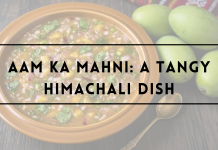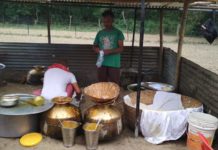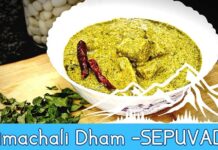Himachal Pradesh is often celebrated for its snow-capped mountains, lush valleys, and tranquil villages, but its cuisine is just as rich and soulful. While dishes like Madra, Sheera, and Siddu have started gaining popularity outside the region, many traditional Himachali recipes remain under the radar.
One such dish is Ambua, a tangy, seasonal preparation that captures the true spirit of Himachali home cooking.
What is Ambua & Why is It Special?
Ambua is a simple, rustic curry made from raw or half-ripe green mangoes, often found in the lower and mid-hills of Himachal during the summer and early monsoon season. These mangoes, known locally as ambis, are much smaller and tangier than the commercial varieties. Their intense sourness makes them perfect for cooking, especially in dishes like this one, where tartness is not just welcomed but celebrated.
What makes Ambua unique is its flavour profile, a delicate balance of sour, sweet, and spicy notes. Simmered with mustard oil and a handful of spices, this dish is a perfect example of the Himachali food philosophy: minimal ingredients, maximum flavour, and seasonal eating.
How is Ambua Prepared?
Here’s a structured recipe similar to what’s described in the Facebook‑referenced post, adapted to a clear and accessible format:
Ingredients for Ambua :
- 3 small, sour wild mangoes (ambis)
- 1 tablespoon arhar dal (split pigeon peas)
- Mustard oil (about 1 tbsp)
- ½ teaspoon mustard seeds
- ¼ teaspoon fenugreek seeds (methi)
- A pinch of asafoetida (hing)
- ½ teaspoon turmeric powder
- ½ teaspoon red chilli powder
- Optional: 1 inch of ginger (grated) and 2 cloves of garlic
- Optional: finely chopped onion (small)
- Salt, to taste
- Jaggery or sugar, to balance the sourness
- Water (about one cup)
Recipe to Make Ambua
There are slight regional or household variations, but the core method is consistent:
- Peel the wild mangoes and cook them with arhar dal in a pressure cooker using about one cup of water. Let it cool, then squeeze or mash the pulp, discarding any significant, fibrous bits.
- Heat mustard oil in a pan until it’s hot. Add mustard seeds and let them crackle. Then stir in asafoetida and fenugreek seeds.
- Optionally, add grated ginger and garlic, then the chopped onion. Sauté until onions become translucent and slightly golden.
- Mix turmeric and red chilli powder, followed by the mango‑dal pulp. Stir everything together.
- Add salt, and if needed, pour in a bit of water to achieve a curry-like consistency.
- Let the mixture simmer on low heat for about 10–15 minutes, allowing flavors to meld and the sauce to thicken.
- Stir in a small amount of jaggery or sugar, tasting and adjusting for the perfect balance of sweet and sour.
- Serve hot with steamed rice or fresh chapati for a tangy, hearty meal.
View this post on Instagram
A touch of jaggery or sugar is usually added at the end to balance the sourness. The result? A delicious dish that’s bright, zesty, and incredibly satisfying with steamed rice or freshly made roti.
The Cultural Roots of Ambua Run Deep
This dish isn’t just a recipe, it’s a connection to tradition, nature, and sustainable cooking. Families once relied on natural yields (like fallen wild mangoes) and minimal spices to create nourishing food. Ambua remains vegan, gluten‑free, and easy to make with pantry staples.
Using locally sourced wild mangoes makes it inherently sustainable. It’s the kind of dish that aligns perfectly with modern values, such as zero food waste and seasonal eating.
Final Thoughts
If you’ve never tasted Ambua, consider this your invitation. Its bold tang, gentle sweetness, and earthy depth are unlike any mango dish you’ve had. Knowing that you’re cooking something deeply rooted in a Himalayan region, using ingredients that locals have cherished for generations, adds richness to every bite.
Have you tried making Ambua, or do you remember it from your childhood? Share your experience or recipe – it’d be lovely to hear your version of this classic Ambua Himachali dish.


















![Himachal Day: Read All About Himachal Pradesh day [15 April] Himachal Pradesh Day - BeingPahadia](https://www.beingpahadia.com/wp-content/uploads/2025/02/Himachal-Pradesh-Day-BeingPahadia-218x150.png)



![Sidh Baba Balak Nath Shahtalai Temple in Deotsidh [Guide] Baba Balak Nath Temple Deotsidh](https://www.beingpahadia.com/wp-content/uploads/2023/04/Baba-Balak-Nath-Temple-Deotsidh-e1681616986690-100x70.jpg)

